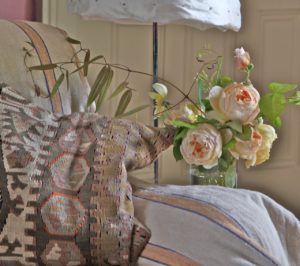A vignette of kelim joy with a Rumanian hemp cart cover over the sofa and roses form the garden
Scraps of worn out kelim rugs make beautiful cushions, especially when the fibres were hand dyed with vegetal materials, they age so gracefully.
A flat tapestry-woven carpet woven by the tribal communities of Anatolia, the Balkans, the Caucasus and the Middle East. Kelim rugs are made from wool, cotton or goat hair–whichever the local climate supports–and coloured from the supply of local vegetation or traded minerals. The older are the most prized, soft in feel and appearance. The rug is woven in narrows widths that are stitched together to made floor rugs–these are weak points to watch out for, though they are easily mended and repaired
There is seemingly no one loom size; also, that kilims are sometimes used as a single ‘panel’, and that kilims made of stitched panels might generally be antique, as contemporary rugs tend to be woven in one piece…
Two basic types of looms—vertical and horizontal—have been used in kilim weaving. Flat-woven as well as knotted kilims were prepared on vertical looms. Patterns were produced by the interlocked tapestry weave: the wefts were woven back and forth into the warp by hand until the desired color area was defined. Then the background was woven in mechanically. Horizontal looms, which are mainly for geometric patterns, were introduced later. Today kilims are produced in the traditional way and on the somewhat more modern Axminster and Jacquard machines.”
Kelim colour mixtures and designs work perfectly in comfortable rooms and colour schemes, combining with all floral prints and geometric weaves. They seem made for each other, which is perhaps not so surprising when we consider that for thousands of years, textiles, designs, colours and threads, materials, ideas and inspirations have travelled from China to North Wales and back again. Notions of caravanserei of exuberant, clashing yet harmonious colours and textiles, gypsy style, thus resurface from our nomadic past. See also Qashqui and Shiraz.
The complete beauty of kelims is their abilty to mix with every other textile- here on a wooden floor, leather and cotton velour sofas, an ancient leather drum, painted silk and hemp and silk mixes to border and on the cushions, with lime washed walls. All textures and elements the rug would recognise form it’s Persian and Middle Eastern origins.
http://www.rugstoreonline.co.uk/article/tools-and-materials
http://nazmiyalantiquerugs.com/articles/collecting-kilims-of-turkey/


